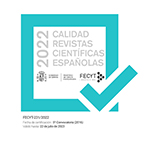Diversidad liquénica asociada a fenómenos post-incendio en los alcornocales valenciano-castellonenses.
Abstract
FOS, S., CALATAYUD, A. & BARRENO, E. 2001. Lichen diversity associated with post-fire colonization in the Valenciano-castellonense cork-oak forests. Bot. Complutensis 25: 103113. 103 Simón Fos et al. Diversidad liquénica asociada a fenómenos post-incendio... The post-fire colonization of the burned barks of cork-oaks (Quercus suber L.) by epiphytic lichens affected by fire episodes has been studied in different areas of the Valenciano-castellonense cork-oak forests (Asplenio onopteridis-Querco suberis sigmetum). These forests, which have been affected by fires of different intensity, are located in Espadán and Calderona mountains and in the Desierto de Las Palmas and differ with respect to their bioclimate and forest structure. This facts result in a different floristic composition of the epiphytic communities prior to the occurrence of fires. The aim of this paper is to determine the recolonization state and to identify the factors involved in the process. Specific richness and coverage of the epiphytic communities show differences between areas. These differences are related with the proximity to undisturbed areas and with its bioclimatic characteristics. 40 species have been identified: 18 crustose (45%), foliose (45%) and 4 fruticose lichens (10%). Secondary succession is dominated by species with wide ecological tolerance with soredia or isidia. Hyperphyscia adglutinata, Physcia adscendens, Ph. tenella and Scoliciosporum chloroccocum show the greatest colonization success; others, such as Evernia prunastri, P. tiliacea, P. soredians, P. subrudecta, Ramalina farinacea, etc., show higher frequency and thallus development in forests which were affected by less intense fires and with subhumid ombroclimate.Downloads
Article download
License
In order to support the global exchange of knowledge, the journal Botanica Complutensis is allowing unrestricted access to its content as from its publication in this electronic edition, and as such it is an open-access journal. The originals published in this journal are the property of the Complutense University of Madrid and any reproduction thereof in full or in part must cite the source. All content is distributed under a Creative Commons Attribution 4.0 use and distribution licence (CC BY 4.0). This circumstance must be expressly stated in these terms where necessary. You can view the summary and the complete legal text of the licence.







